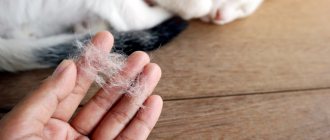This reaction occurs when pet dander (skin flakes), saliva or fur comes into contact with a child’s skin. Sometimes cats themselves do not cause an immune reaction, but may carry other allergens on their fur, such as pollen or dust.
Allergy to cats in infants
An allergic reaction is a specific response of a child’s immune system to an allergen. In this case, the allergen is cat hair. The body perceives it as a dangerous body, and the immune system begins to defend itself. Defense mechanisms are activated and symptoms include nasal congestion, skin rash and severe cough.
Important: Allergies do not appear to the animal’s fur itself, but to a special protein, which is also found in saliva, urine, and is secreted on the skin in the form of dandruff.
Normal allergy symptoms are not particularly dangerous for an infant, but they can cause complications that can seriously impair health, such as swelling of the larynx, which can lead to suffocation.
How does the disease manifest in a newborn?
Allergy to cats causes symptoms in newborns, both through direct contact with the pet and from things and objects with which it has been in contact. They can also appear immediately during communication and after a few hours. Another feature of the manifestation of the disease is seasonality - it practically does not occur in winter, but with the onset of spring it sharply worsens.
How does an allergy to cats manifest in infants? Symptoms in children look the same as in adults. Signs can be disguised as other diseases, so it is especially important for parents to identify the symptom in time and seek medical help in time so as not to cause complications.
Allergy symptoms in infants
The signs of this disease are pronounced in newborns, so it is not difficult for parents to notice them.
Allergy to cats in infants - symptoms:
- Rhinitis – nasal congestion;
- Frequent sneezing;
- The appearance of a rash on the skin in the form of red dots or spots;
- Red and teary eyes that the child constantly tries to scratch;
- Swelling, especially around the eyes and lymph nodes;
- Drowsiness, lethargy and capriciousness of the baby;
- Severe dry cough in attacks;
- The appearance of shallow breathing, shortness of breath;
- Difficulty breathing;
- Wheezing and whistling when breathing;
- Discharge of mucus from the nasal cavity.
The symptoms are similar to ARVI, bronchitis and other diseases, but self-medication is strictly prohibited so as not to cause serious consequences.
Clinical picture as pathology develops
Allergies develop in 4 stages:
- Immune – begins from the moment the allergen first enters the child’s body.
- Pathochemical – from the moment of secondary penetration. The immune system protects the body by releasing eosinophils, cells that cause inflammation - histamines.
- Pathophysiological - the cells of the epidermis and mucous tissue do not function properly for a long time, causing swelling and excessive mucus secretion.
- Clinical – the stage of acute onset of symptoms. In infants they appear much more clearly than in adults.
Outwardly, the disease can be noticed only at the fourth stage. The main thing is not to trigger pathology.
Drug treatment
If a baby has symptoms of an allergy to cats, he needs urgent help. Newborns are prescribed the following:
All medications are prescribed by a specialist taking into account the child’s age, so they cannot harm him. Treatment is carried out at home, in a hospital only in case of complicated course of the disease. The course continues for the required number of days, even if obvious improvements are noticeable during therapy.
It is impossible to completely cure cat allergies, but therapy can reduce the symptoms of the disease and avoid complications.
Diagnosis of allergies in a baby
If symptoms of the disease are noticed, the first step is to reduce or completely eliminate contact between the pet and the child. You can also give the cat to relatives or close friends for a while.
Important: do not immediately blame your pet for the disease, since it can only be a carrier of the disease. Only an allergist can find out the exact cause of the allergy.
If allergy symptoms in newborns do not disappear or subside, then you need to look for other reasons for their manifestation. But when they have passed, tests are needed that can accurately identify the cause of the appearance of allergens. It is possible that an allergic reaction may only occur to a certain type or breed of cat.
Timely diagnosis in the early stages of its occurrence will make it easier and faster to overcome the disease, therefore, at the first appearance of signs, you need to consult a doctor.
Which doctor should I go to?
First of all, if any symptoms of the disease appear, you need to contact a pediatrician, who will collect a primary medical history, conduct an examination of the allergy sufferer and give a referral to an allergist.
Often mothers turn to a neonatologist with very tiny babies - he will also give a referral to an allergist, and possibly prescribe tests. It makes no sense to contact a dermatologist, since allergies are not his specialty; he will also refer you to an allergist. There is a nephrologist who treats complications of an allergic reaction, such as acute glomerulonephritis.
It is the allergist who will be able to prescribe the necessary tests, research methods and prescribe the necessary treatment. He also prescribes disease prevention and treats consequences.
Research methods
The allergist conducts an initial examination of the child’s skin, eyes and nasal passages, and then prescribes tests.
There are three ways to identify the exact allergen:
- Venous blood analysis - a test is performed to determine the amount of antibodies or immunoglobulin E that react to a specific allergen;
- Skin test - the skin is pricked or the allergen is injected under the skin of allergy sufferers. Results are visible within 20 minutes: if blisters larger than 2 mm appear, the reaction is considered positive.
- Test provocation - a few drops of a solution with an allergen are instilled into the eyes and nose, and if irritation appears in the form of redness, rhinitis, sneezing and tears, then this is a positive reaction to the disease.
Skin tests are not prescribed for children under 3 years of age. They take blood from a vein, and also take blood from their parents to determine whether allergic reactions are hereditary.
After identifying the exact type of allergen, the doctor prescribes treatment and gives advice on reducing symptoms and prevention.
When will you have to get rid of your pet right away?
If your pet is the culprit of the allergic reaction, and the symptoms are extremely acute, and treatment does not help, then you need to give your pet away at least for a while. Allergies have many complications, such as asthma and choking, that no parent wants to see in their child. Therefore, the first thing you need to do is remove the allergen from the baby, in this case the cat.
If after a few weeks, when the pet comes into contact with the baby again, the reaction is the same or worse, then the animal will need to be given away forever.
Features: There is another opinion - the cat itself can cure allergies. Often, when playing, animals scratch or bite, thereby releasing the allergen under the skin, and the immune system constantly produces antibodies, which after some time can cure the newborn of the disease.
But this is a specific opinion, and no doctor will prescribe such treatment, but there are a large number of cases when this method worked favorably.
Where to put a cat if you don't need it?
According to the geographic service WorldAtlas, Russia is one of the top three countries with the largest cat population. Sellers of pet products also regularly conduct careful calculations of the cat family. So, according to the latest information, there are more than 30 million domestic cats in the country.
Russia also breaks all records in terms of the number of stray animals, which means that cats are constantly wandering from the street to “good hands” and back. It is somehow not customary to talk about where to put a cat if it is not needed - they will be considered a flayer.
But cases when a pet becomes a burden are all too common, and statistics only confirm this.
How to cure a baby?
Treatment for the baby can only be prescribed by the attending allergist. In addition to medications, he prescribes methods for eliminating symptoms and prevention.
The main methods of treatment include:
- Medicines – antihistamines that neutralize allergens, as well as decongestants to improve the condition of the nasal mucosa;
- Therapy – to relieve symptoms using non-medicinal methods;
- Allergen injections under the skin are used quite rarely; they are not used for infants. Thus, resistance to allergens is developed faster.
As a preventative measure, the following is prescribed:
- Reducing contact with animals;
- Wet cleaning of the house - at least 2-3 times a week;
- Frequent daily ventilation;
- Cleaning cat accessories - bowls, scratching posts, toys and others, as well as reducing the child’s contact with them and with cat food.
Treatment should be comprehensive; you should take the medication in a course prescribed by the doctor. You cannot self-medicate. If treatment does not help or worsens the patient's condition, the doctor should prescribe another drug.
Live healthy! Three tests for cat owners. (03/01/2016)
Medicines for infants
A child under one year old, if an allergic reaction occurs, needs immediate help. Newborns should not take antihistamines. It is not recommended to give other medications so as not to lead to complications.
Infants are prescribed chamomile decoction or tea, as well as salt baths to reduce swelling of the mucous membranes and calm the nervous system. To remove redness and rashes on the skin, add chamomile to the bath.
Children under one year of age are prescribed the drug Fenistil in the form of drops or ointments. At six months of age, you can take sedatives - Zyrtec or Peritol. In severe cases, with prolonged allergies, children are hospitalized and corticosteroid hormones are administered.
Is it possible to use folk remedies?
As with the treatment of many diseases, folk remedies are used for allergies. But they are specific, and they can only be used after consultation with your doctor.
For traditional treatment, tinctures and decoctions of herbs and plants are used, which can alleviate the child’s condition by eliminating the symptoms. Duckweed tincture, dandelion juice, decoctions of chamomile, St. John's wort, celandine and others are often used.
Basically, the use of folk remedies does not harm the patient’s body, but they can only be used after the approval of an allergist, in combination with drug treatment.
Prevention
Due to the fact that the presence of cats in the house often provokes allergic reactions in newborns, experts do not advise parents to have them in the house until the baby is 3 years old.

If a pet already lived in the apartment, then with the appearance of a baby, pediatricians advise doing the following:
- Carry out wet cleaning daily.
- Ventilate the room frequently. It is recommended to use an air purifier and ionizer.
- Limit contact between the child and the cat. Do not allow your pet into the newborn's room and keep toys and baby things away from it.
- Remove curtains and carpets from the child’s room, because cat fur gets deposited on them.
- All family members should monitor their hand hygiene.
- Strengthen the baby's immunity.
All these recommendations will significantly reduce the symptoms of an infant’s allergic reaction to cats. If signs of pathology appear in a child constantly after contact with a pet, then to prevent this, you should find a new home for the pet.
Possible complications in newborns
With improper treatment, a protracted form of the disease, or no treatment, allergy complications may occur. These include:
- Chronic rhinitis;
- Dermatitis;
- Bronchial asthma;
- Swelling of the larynx, and as a result - suffocation;
- Anaphylactic shock and others.
To prevent serious consequences, you need to identify allergy symptoms in time, consult an allergist and begin treatment.
Allergy to cats in newborns is a common occurrence when the immune system is weakened; in this case, it is not always necessary to give up the pet. The symptoms are quite pronounced, so allergies are easy to determine. After this, you need to identify the exact allergen and begin treatment. There are many ways to treat and prevent the disease. But the main thing here is not to start pathology, so as not to cause complications in the form of chronic diseases or severe attacks.








